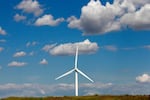The largest proposed wind farm in Washington got a partial thumbs up on Wednesday from the state’s energy siting council. The controversial project in southeastern Washington has raised concerns about ridgeline views, tribal cultural resources and endangered hawks.

File - This file photo taken May 18, 2011, shows a wind turbine near Arlington, Ore.
Rick Bowmer / AP
In a 5-2 vote, Washington’s Energy Facility Site Evaluation Council, or EFSEC, recommended approving the Horse Heaven Hills Clean Energy Center, with a reduced number of wind turbines.
“We have spent a lot of time reviewing this project, gathering information about the impacts, gathering information about the project itself,” said Kathleen Drew, EFSEC chair. “By partially approving the Horse Heaven wind and solar project, EFSEC is balancing the need for renewable, clean energy with potential impacts on tribal cultural resources, wildlife and surrounding communities.”
Benton County representative Ed Brost and the Department of Natural Resources representative Lenny Young opposed the approval recommendation.
The project will head to Washington Gov. Jay Inslee’s desk. He can approve the project, reject it, or send it back to the council’s drawing board. Inlsee has 60 days to make a decision.
If Inslee signs off, the renewable energy project would be built near the Tri-Cities in unincorporated Benton County.
Scout Clean Energy initially proposed up to 244 wind turbines that would stretch along 24 miles of blustery ridgelines–some proposed turbines with a maximum height of 671 feet, which is taller than the Space Needle. The company also proposed three locations for solar arrays.
However, the council recommended slashing the number of wind turbines nearly in half and limiting where the solar arrays could be placed. Its goal was to better protect cultural resources, wildlife corridors and endangered ferruginous hawks nesting in the area.
Earlier this year, the developers said those restrictions could render the project “nonviable.”
In a March letter to the council, Gerald Lewis, Yakama Nation Tribal Council chairman, wrote that a judge had ruled the project’s economic feasibility shouldn’t be adjudicated.
In addition, Lewis wrote, the project would “irrevocably damage” traditional cultural properties, or TCPs. Those treaty-reserved resources and sacred areas include ceremonial, burial, legendary and monumental sites, according to the tribe.
“Scout’s continued dismissal of sensitive material shared by Yakama Nation members and professional archeologist suggests an unwillingness to listen or an intentional misunderstanding of federal treaty-reserved rights,” Lewis wrote.
After EFSEC’s recommendation, Lewis said he was disappointed with the decision, noting that the council didn’t apply the same concern for wildlife to cultural resources.
“Yakama Nation was not involved in the project’s siting and design decisions and instead was forced to respond through a permitting process that prejudiced our ability to engage in meaningful dialogue about responsible energy siting,” Lewis said in a statement.
Moreover, he said, the Yakama Nation provided plenty of evidence for further project modification. The EFSEC council ignored that evidence, he said.
In April, Michael Rucker, president and CEO of Scout Clean Energy, sent a letter to the EFSEC that said the restricted plan could do more than reduce energy output at this site.
“If applied to future projects, (these standards) would restrict renewable energy siting on nearly a fifth of the state’s Columbia Plateau Ecoregion,” Rucker wrote.
The debate over the project and the council’s turbine reduction drew 973 comments from people living nearby, interest groups and the Yakama Nation.